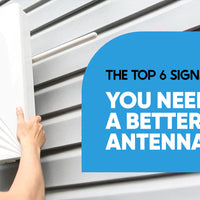In the era of streaming services and digital content, many people are rediscovering the benefits of traditional TV antennas. A quality TV antenna can access local channels without the monthly cable or satellite TV cost. To make the most of this cost-effective solution, selecting the best antenna for your specific needs is crucial. An "unlimited antenna," a term often used to describe high-performance antennas with extensive range capabilities, can be a game-changer in accessing a wide array of local channels. Here's a comprehensive guide to help you find the best TV antenna for your local channels.
Understand Your Reception Needs
The first step in finding the best antenna is understanding the reception type you need. TV antennas come in various types, each suited for different reception environments:
- Indoor Antennas are ideal for those living in urban or suburban areas with strong signals. They are easy to install and less obtrusive.
- Outdoor Antennas are better for rural or suburban areas where signal strength may be weaker. These antennas are usually mounted on rooftops or poles and offer a greater range.
An "unlimited antenna" typically refers to high-quality outdoor models or indoor antennas with advanced features that maximize reception capabilities. To determine which type suits you best, check the signal strength and distance from local broadcast towers using online tools like the antenna web or the FCC's DTV reception maps.
Evaluate Antenna Range
The range of an antenna is a crucial factor in determining its effectiveness. Antennas are generally rated for specific distances, and an "unlimited antenna" often boasts an extended range, allowing it to pick up signals from farther away.
Consider these factors:
- Distance from Broadcast Towers: Use a signal map to estimate the distance between your home and the nearest broadcast towers. Choose an antenna with a range that comfortably exceeds this distance.
- Obstructions: Buildings, trees, and hills can obstruct signals. If you're in an area with many obstructions, you might need a more powerful antenna to overcome these challenges.
Check Signal Reception Quality
A high-performance antenna should have a long-range and provide clear, reliable signal reception. Look for antennas that feature:
- Amplification: Built-in amplifiers can boost weak signals, particularly useful in areas with low signal strength.
- Signal Filter: Some antennas come with filters to reduce interference from cellular signals and other electronic devices, improving reception clarity.
An "unlimited antenna" often includes these features to ensure optimal performance in diverse environments.
Consider the Type of Channels
Different antennas are better suited for different types of channels:
- VHF (Very High Frequency): Essential for channels in the 2-13 range.
- UHF (Ultra High Frequency): Channels in the 14-69 range are needed.
Many modern antennas are designed to receive both VHF and UHF signals. Ensure your antenna supports both frequencies if you want comprehensive channel access, including local news and network programming.
Installation and Placement
Proper installation is key to getting the most out of your antenna. For indoor antennas, experiment with different placements to find the spot with the best reception. Placement near windows or higher up in the room often yields better results.
Installation involves mounting an outdoor antenna on a pole or roof and ensuring it's directed toward the broadcast towers. Many outdoor antennas are designed to withstand weather conditions, making them suitable for long-term use.
Read Reviews and Compare Models
Before making a purchase:
- Read customer reviews and compare different models of antennas.
- Look for feedback on reception quality, ease of installation, and durability.
- Pay attention to reviews that mention performance in conditions similar to yours, such as urban, suburban, or rural environments.
An "unlimited antenna" should have a proven track record of high performance and reliability. Some reputable brands include Mohu, RCA, and Antennas Direct, which are known for their innovative designs and effective reception.
Budget and Warranty
While a higher price doesn't always guarantee better performance, investing in a quality antenna can offer long-term benefits. Compare features against the cost to find the best value. Additionally, consider the manufacturer's warranty, which can offer peace of mind and protection for your purchase.
In Sum
Finding the best TV antenna for your local channels involves:
- Understanding your reception needs.
- Evaluating the antenna's range and signal quality.
- Considering factors like channel type and installation.
An "unlimited antenna" can be a great option for those seeking robust performance and extensive range. By following these guidelines and doing thorough research, you'll be well on your way to enjoying a diverse array of local programming without the expense of a cable subscription.
Check out our Products:
















